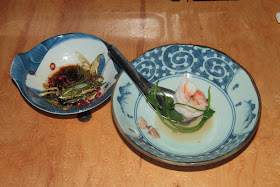Monday, February 25, 2013
hot pot 打邊爐
Most Asian culture has a hot pot or hot pot like dish. Many has a few different version and Chinese is no exception. Korean ones typically are quite spicy as well as (heat) hot. Japanese has shabu shabu which is very mild.
Chinese hot pot typically are called 火鍋 - poorly translated as fire wok. For me 火鍋 really mean the very spicy and (heat) hot version. The Southwest Chinese hot pot is quite different. It is never spicy and (heat) hot. It is very similar to the Japanese's shabu shabu. Instead of over-the-top spicy and hot, the Cantonese prefers a very light and clear broth. The reason is to preserve the delicate tastes of the ingredients of the vegetable, fish, and shellfishes.
The best time to have hot pot is winter. There is nothing like a group of family or friends huddle around a fire and cook while you eat and drink. In the old days most houses has no central heating. Having a group of people sitting around a hot pot is the best way to dispel the biting cold. That is why Chowzhou people 潮州 call eating late in cold days 打冷 - meaning beating 打 the cold 冷.
Instead of calling hot pot 火鍋 Cantonese calls it 打邊爐. Unfortunately I could not come up with a good English translation.
The ingredients for Chinese hot pot 火鍋 are vast. Almost any fresh ingredients may be used. The one universal practice is there is always a lot of vegetable - and I mean a lot. Meat and fish typically are sliced very thin so they cook fast as well as encourage one to savoy.
I prefer the Cantonese hot pot 打邊爐 because it preserves the delicate essence of the delicate ingredients. It the also the easiest one to prepare. If you can boil water you can prepare a savory hot pot. While most people may start with a broth, you can start with just water. The accumulation of the flavor from all the ingredients during the course of eating will turn the water into the most tasty broth at the end.
you can use just about any pot; i picked this japanese clay pot because of it's beauty
here are some of the ingredients I used in this meal - mussels, wild prawns, shitake mushroom, pork, a kind of Chinese lettuce and cilantro 香菜
I happened to have a pork bone soup so I used it instead of starting with just water
I made a dipping sauce (left) out of light soy sauce, salad oil, sliced scallion and chopped Thai chili
it is important to keep the flame low so the broth just barely boiling; this way you will not have to constantly add water to the broth as it boil away too fast
One eats a lot of vegetable during the course of the hot pot. Normally there should be a few variety but in this meal I am limited to what I have at home.
I prepared some Chinese puffy noodle 伊麵 - I hydrate them by simply boiling them in water to soften them
in my town this is the best Chinese puffy noodle 伊麵 - it comes from Vancouver BC
drained and rinse with cold water to stop the cooking
the puffy noodle 伊麵 is eaten with the very savory broth towards the end
second serving - I top it with some crab meat that I happen to have around












No comments:
Post a Comment